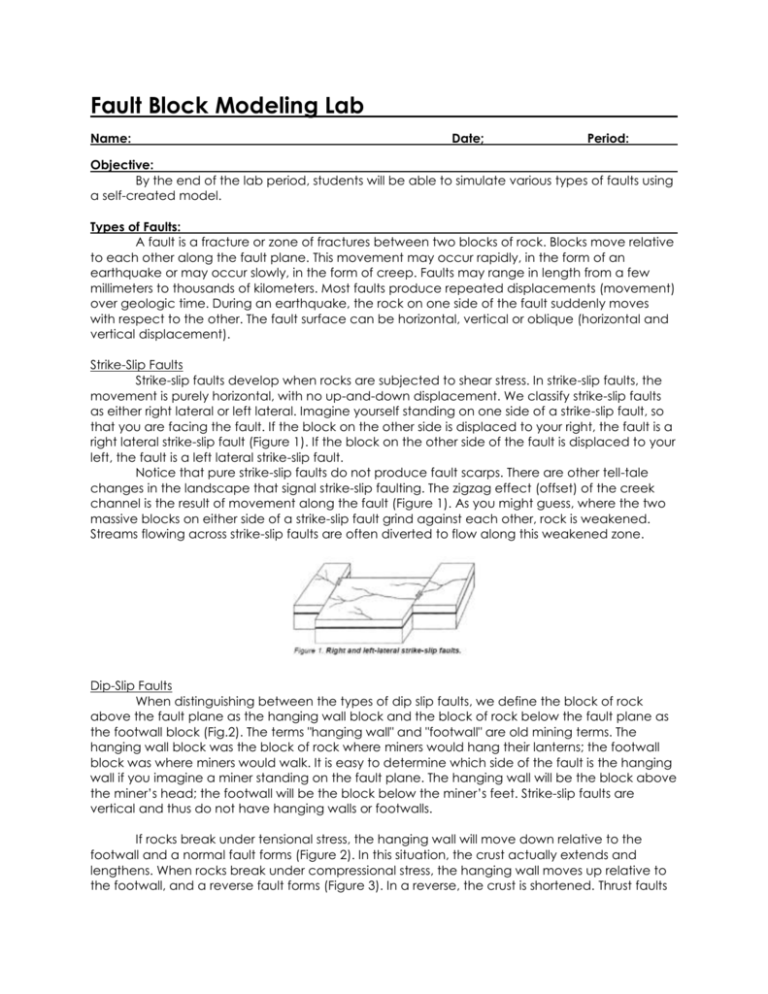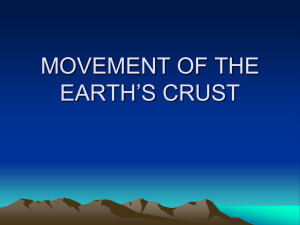File
advertisement

Fault Block Modeling Lab Name: Date; Period: Objective: By the end of the lab period, students will be able to simulate various types of faults using a self-created model. Types of Faults: A fault is a fracture or zone of fractures between two blocks of rock. Blocks move relative to each other along the fault plane. This movement may occur rapidly, in the form of an earthquake or may occur slowly, in the form of creep. Faults may range in length from a few millimeters to thousands of kilometers. Most faults produce repeated displacements (movement) over geologic time. During an earthquake, the rock on one side of the fault suddenly moves with respect to the other. The fault surface can be horizontal, vertical or oblique (horizontal and vertical displacement). Strike-Slip Faults Strike-slip faults develop when rocks are subjected to shear stress. In strike-slip faults, the movement is purely horizontal, with no up-and-down displacement. We classify strike-slip faults as either right lateral or left lateral. Imagine yourself standing on one side of a strike-slip fault, so that you are facing the fault. If the block on the other side is displaced to your right, the fault is a right lateral strike-slip fault (Figure 1). If the block on the other side of the fault is displaced to your left, the fault is a left lateral strike-slip fault. Notice that pure strike-slip faults do not produce fault scarps. There are other tell-tale changes in the landscape that signal strike-slip faulting. The zigzag effect (offset) of the creek channel is the result of movement along the fault (Figure 1). As you might guess, where the two massive blocks on either side of a strike-slip fault grind against each other, rock is weakened. Streams flowing across strike-slip faults are often diverted to flow along this weakened zone. Dip-Slip Faults When distinguishing between the types of dip slip faults, we define the block of rock above the fault plane as the hanging wall block and the block of rock below the fault plane as the footwall block (Fig.2). The terms "hanging wall" and "footwall" are old mining terms. The hanging wall block was the block of rock where miners would hang their lanterns; the footwall block was where miners would walk. It is easy to determine which side of the fault is the hanging wall if you imagine a miner standing on the fault plane. The hanging wall will be the block above the miner’s head; the footwall will be the block below the miner’s feet. Strike-slip faults are vertical and thus do not have hanging walls or footwalls. If rocks break under tensional stress, the hanging wall will move down relative to the footwall and a normal fault forms (Figure 2). In this situation, the crust actually extends and lengthens. When rocks break under compressional stress, the hanging wall moves up relative to the footwall, and a reverse fault forms (Figure 3). In a reverse, the crust is shortened. Thrust faults (Figure 4) are simply reverse faults in which the angle formed by the fault plane and the surface is quite shallow. Commonly, the fault plane itself can become grooved and polished as one block of rock scrapes against the other. The scratches on the fault plane surface are called slickensides. Slickensides may record the slip orientation of the fault plane, and may even feel smoother in the direction of slip. There is another relationship between rocks on either side of the fault plane that can be used in distinguishing normal and reverse faults and are seen in Figures 2 and 3. If the rocks are right side up then the normal fault brings down younger rocks over older rocks. Under the same conditions the reverse fault moves older rocks over younger rocks. 1. Referring to Figure 1, does it make any difference which side of the fault you stand on in naming the right-lateral or left lateral strike-slip fault? Explain. 2. Compare and contrast a reverse fault and a thrust fault. 3. Explain how slickensides are used to determine the slip orientation of the fault plane. Lab Procedures: 1. Cut out both shapes, leaving the black tabs on the model. Write names on line before you begin folding and adhering. 2. Fold at appropriate edges and glue all the XYZ layers together using the tabs. 3. Tape the bottom to the model (too hard to glue) Normal Fault: 1. Locate points A and B on your model. Move point B so that it is next to Point A. Observe your model from the side (its cross-section). 2. Draw the normal fault as represented by the model you have just constructed. Label the hanging wall and footwall: Questions: 1. Which way did point B move relative to point A? 2. What happened to rock layers X, Y and Z? 3. Are the rock layers still continuous? 4. What likely happened to the road? The railroad tracks? 5. Is this type of fault caused by tension, compression or shearing? Reverse Fault: 1. Locate points C and D on your model. Move Point C next to point D. Observe the crosssection of your model. 2. Draw the reverse fault as represented by the model you have just constructed. Label the hanging wall and footwall: Questions: 1. Which way did point D move relative to point C? 2. What happened to rock layers X, Y and Z? 3. Are the rock layers still continuous? 4. What likely happened to the river? 5. Is this type of fault caused by tension, compression or shearing? Explain. Strike-Slip Fault: 1. Locate points F and G on your model. Move the pieces of the model so that point F is next to point G. 2. Draw an overhead view of the surface as it looks after movement along the fault: Questions: 1. If you were standing at point F and looking across the fault, which way did the block on the opposite side move? 2. What happened to rock layers X, Y, and Z? 3. Are the rock layers still continuous? 4. What likely happened to the river? 5. Is this type of fault caused by tension, compression or shearing? Explain. 6. Is the strike-slip fault a right or left – lateral movement? Explain. Reinforcement Questions: 1. Explain the miner's method of naming faults. 2. Use a simple diagram showing the shaft, fault line, hanging wall, and footwall for normal and reverse faults. How did the walls get their names? 3. Name and describe the types of faults and folds that form in convergent margins. Use a simple diagram to illustrate your answer. 4. Name and describe the types of faults that form in a rift valley/mid-ocean ridge. Explain why normal faults form at divergent boundaries. Use simple diagrams to illustrate both answers. 5. Name and describe the types of faults that form along a transform boundary. Use a simple diagram to illustrate your answer. Review Questions: How Do Earthquakes Happen Along Plate Boundaries and Faults? Earthquakes occur when there is a sudden movement on the Earth’s crust. Most movement on the Earth’s crust takes place along plate boundaries. There are three main types of plate boundaries; they include converging (moving together), diverging (moving apart), and sliding or transform plate boundaries. There is a direct correlation between the plate boundary and the type of fault associated with an earthquake. Figure 1: Types of Faults 1. Complete the chart below to distinguish between each of the three main types of faults. The block diagrams below illustrate a simplified version of a normal and reverse fault. The arrows by each fault show the relative motions of the blocks on both sides of the fault. 2. Draw an arrow on each side of the fault on BOTH diagrams to illustrate the movement along the faults. 3. Indicate in BOTH diagrams which side has younger rocks and which has older rocks at the surface? 4. What is the difference between the hanging wall and the footwall? 5. On an eroded normal fault, are the rocks at the surface on hanging wall side the youngest or oldest surface rocks? Describe fully. 6. On an eroded reverse fault, are the rocks at the surface on the hanging wall side the youngest or oldest surface rocks? Describe fully.







